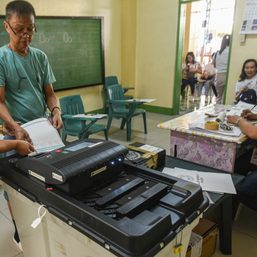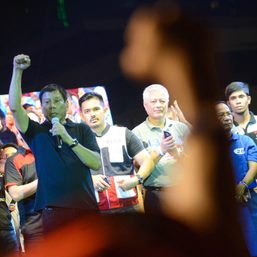SUMMARY
This is AI generated summarization, which may have errors. For context, always refer to the full article.
![[ANALYSIS] Can ranked-choice voting fix Philippine politics?](https://www.rappler.com/tachyon/2020/11/TL-rank-voting-November-6-2020.jpg)
With Donald Trump and Joe Biden neck and neck in the US presidential elections, lots of Filipinos – especially those on Twitter – found themselves frantically doomscrolling since Wednesday, November 4.
Biden was originally projected to have a comfortable lead over Trump, and it seems he’s going to win. Still, poll results show Trump managed a stronger-than-expected performance.
Lots of Americans (and non-Americans, too) understandably fear a repeat of 2016, when Hillary Clinton won the popular vote (garnering 48.2% versus Trump’s 46.1%) but eventually lost to Trump, who ended up with more electoral college votes (304 versus Clinton’s 227).
Plurality presidents are nothing new for Filipinos. Time and again, this has led to endless complaints that most of us don’t actually get to elect the people we really want. At worst, this has spawned animosity and even contempt among us – especially online.
What if alternative voting methods can fix these problems? One such method, called “ranked-choice voting,” is lately becoming more popular in the US and other countries.
What good is it, and can we adopt it here, too?
Problems with plurality voting
Our presidential elections have long been based on “plurality voting,” also called “first-past-the-post.” Each voter gets to vote for one person per position, and the candidate with the most number of votes wins. Simple. Transparent.
But this has known problems.
First, winners typically don’t get the support of the majority of voters. In 2016 President Rodrigo Duterte got 16.6 million votes, which are just 39% of the total. Before him, in 2010 Benigno Aquino III won 42.1% of the votes; in 2004 Gloria Macapagal Arroyo won 40% of the votes.
Arguably, these outcomes tend to undermine the idea of democracy: The will of the majority is never reflected in the final election results, and too many people end up dissatisfied with the winner.
Extremely partisan candidates – those who successfully pander to a sizable voter base – also tend to win by this method. (READ: Why is Duterte still so popular?)
Second, plurality voting is susceptible to the “spoiler effect,” where two or more candidates of like persuasions and platforms can split their voter base, allowing a more extreme candidate to win (think Mar Roxas and Grace Poe splitting the votes and inadvertently paving the way for Duterte’s victory).
How ranked-choice voting works
Ranked-choice voting fixes these problems by telling voters to rank candidates in order of preference (rather than just vote for one person per position).
For example, imagine that only Duterte, Roxas, Poe, and Binay ran in 2016. Instead of voting for just Roxas, you can rank Roxas first, Poe second, Duterte third, and Binay fourth.
Votes for the top choices are counted, and whoever gets more than 50% of the votes wins. But if nobody gets the majority of votes, the weakest candidate (say, Binay) is removed from the race. Binay’s voters’ votes are then transferred to their second choice candidate, and the votes are recounted.
This process gets repeated until someone gets the majority of votes, in which case he or she wins. Candidates, as it were, are repeatedly pitted against one another in a series of runoffs; ranked-choice voting is also called “instant-runoff voting.”
If you revisit the 2016 elections, you can see how ranked-choice voting would’ve significantly altered the results.
If, say, Poe, Binay, and Defensor-Santiago voters had all chosen Roxas second, Roxas would’ve eventually gotten 61% of the votes – thus overwhelming Duterte’s 39%, holding other things constant.
<iframe title=”Throwback to 2016″ aria-label=”chart” id=”datawrapper-chart-1A9yI” src=”https://datawrapper.dwcdn.net/1A9yI/1/” scrolling=”no” frameborder=”0″ style=”width: 0; min-width: 100% !important; border: none;” height=”317″></iframe><script type=”text/javascript”>!function(){“use strict”;window.addEventListener(“message”,(function(a){if(void 0!==a.data[“datawrapper-height”])for(var e in a.data[“datawrapper-height”]){var t=document.getElementById(“datawrapper-chart-“+e)||document.querySelector(“iframe[src*='”+e+”‘]”);t&&(t.style.height=a.data[“datawrapper-height”][e]+”px”)}}))}(); </script>
Apart from allowing a fuller expression of voters’ preferences and avoiding the spoiler effect, ranked-choice voting also lessens the need for “strategic voting,” where voters vote for candidates likely to win rather than those they really want to win.
As a result, independent candidates might be encouraged to run and campaign for causes and interests that wouldn’t be ordinarily heard. Voting for them won’t feel like you’re wasting your vote.
Ranked-choice voting also discourages negative campaigning since candidates will have an incentive to go beyond their voter base and reach out to much broader swaths of the electorate (“If you won’t vote for me first, at least rank me second”).
Hence, it deters extreme partisanship: candidates adopting extreme views and policies are less likely to be placed 2nd or 3rd on the average voter’s ballot.
Drawbacks
Of course, ranked-choice voting has its limits.
First, its results may not be totally fair or satisfying either: Fringe candidates, or those originally ranked lowest by a majority of the people, may end up winning (as illustrated in this TED-Ed video).
More practically, but just as concerning, lots of voters might find the task of ranking candidates confusing, complicated, and tedious. Massive education campaigns will have to teach the electorate how to fill out the new, redesigned ballots, and explain to them exactly how ranked-choice voting works.
Ideally, voters must also rank all candidates. Otherwise, their votes for certain positions might be discarded, inadvertently taking away their voice in the final choice between top candidates.
Despite these flaws, bear in mind that no voting scheme is perfect – a mathematical result derived by Nobel Prize-winning economist Kenneth Arrow way back in 1951. And the problems that bedevil ranked-choice voting also bedevil plurality voting, anyway.
Where is it used?
Australia, New Zealand, and Ireland have used ranked-choice voting for years.
A number of US cities, too, along with one state: Maine. In 2018, Maine became the first US state to use ranked-choice voting in both state and federal elections. This year, they’re the first to use it in a presidential election.
The people of Massachusetts had a chance to vote for ranked-choice voting this year, but the proposal lost by a small margin.
In the Philippines, how might ranked-choice voting be used in our general elections? First and foremost, would it be legal?
Some lawyer friends I asked have yet to look into it. But at least in the case of the president and vice president, the 1987 Constitution only requires that they “be elected by direct vote,” and “the person having the highest number of votes shall be proclaimed elected.”
At first brush, none of these provisions preclude ranked-choice voting. Perhaps it can even be used for other elective posts, too, by mere statute and without having to effect sweeping constitutional change.
Let’s rethink our elections
By itself, ranked choice voting won’t likely remedy most of the problems of Philippine politics, including our toxic culture of patronage, the ubiquity of dynasties, the undying nature of pork, just to name a few.
But a number of basic problems we typically see every election cycle – like the spoiler effect, strategic voting, negative campaigning, extreme partisanship, polarization, and minority rule – can be reasonably traced to the incentives embedded in plurality voting.
Maybe a fundamental rethink of how we elect our leaders is just what we need to bring about sweeping changes in Philippine politics – or maybe not. We won’t know until we try. But let’s start considering it seriously. – Rappler.com
The author is a PhD candidate and teaching fellow at the UP School of Economics. His views are independent of the views of his affiliations. Follow JC on Twitter (@jcpunongbayan) and Usapang Econ (usapangecon.com).
Add a comment
How does this make you feel?









![[Edgewise] God didn’t save Trump from the bullet, immigrants did](https://www.rappler.com/tachyon/2024/07/thought-leaders-trump-immigrants-intervention-07242024.jpg?resize=257%2C257&crop_strategy=attention)
There are no comments yet. Add your comment to start the conversation.